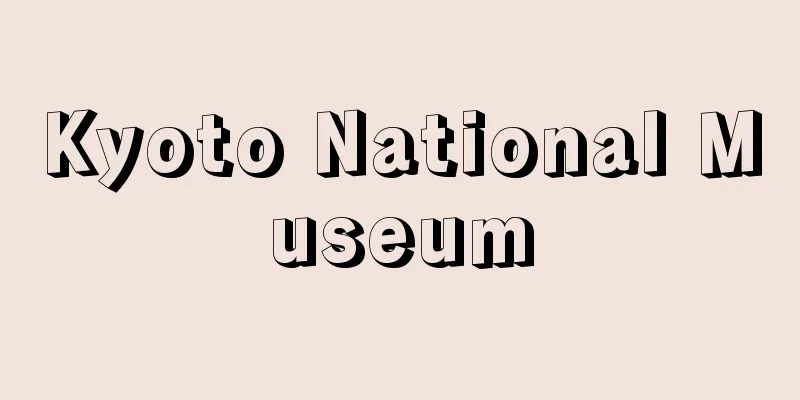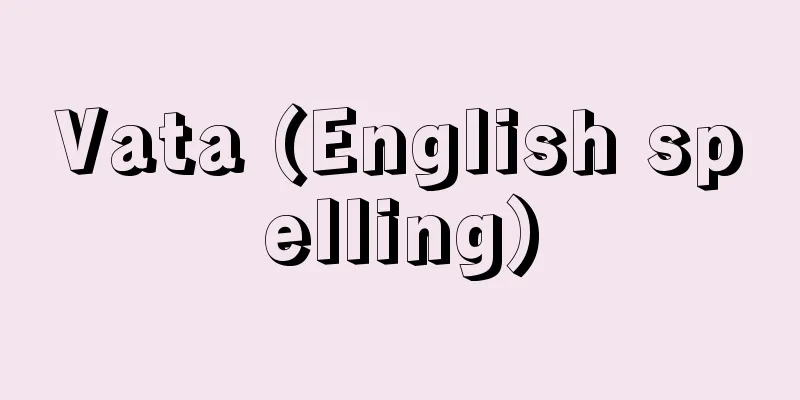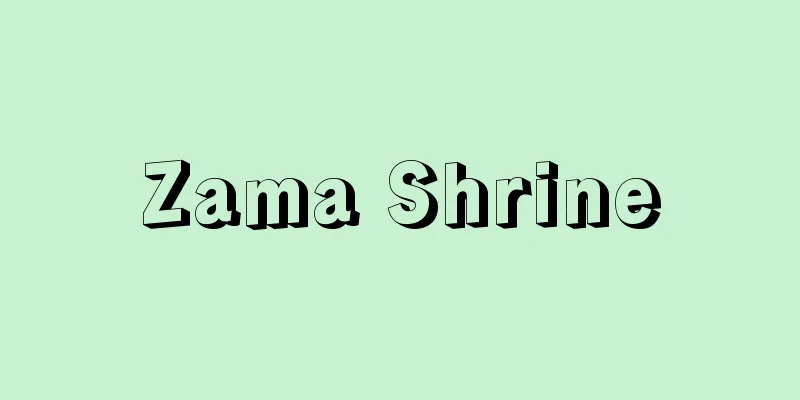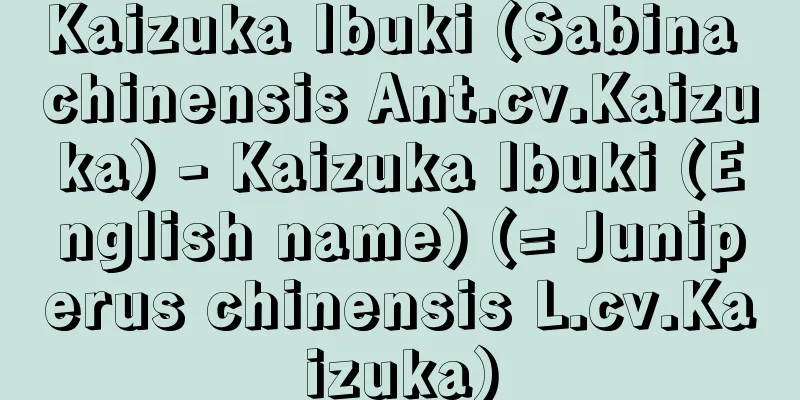Kyoto National Museum

|
This museum is located in Chayamachi (Higashiyama Shichijo), Higashiyama Ward, Kyoto City. In 1889 (Meiji 22), the Library Museum was abolished and the Imperial Museum of Kyoto was established along with the Imperial Museum and Imperial Nara Museum. Construction began in 1892 based on a design by Katayama Tokuma, and it was completed in 1895 and opened on May 1, 1897. In 1900 (Meiji 33), due to a reform of the government system, it was renamed the Imperial Household Museum of Kyoto and placed under the jurisdiction of the Imperial Household Ministry. In 1924 (Taisho 13), it was bestowed upon the city of Kyoto on the occasion of the marriage of the Crown Prince (Emperor Showa), and was renamed the Onshi Kyoto Museum and placed under the management of the city. In 1952 (Showa 27), after the Second World War, it came under the jurisdiction of the Ministry of Education's Committee for the Protection of Cultural Properties (the predecessor of the Agency for Cultural Affairs), and changed to its current name. In 1965, a new building designed by Keiichi Morita (1895-1983) was completed to the west of the main building (Meiji Kotokan) and opened in October 1966. Reconstruction of the new building began in 2009, and the Heisei Chishinkan designed by Yoshio Taniguchi was completed in August 2013 and opened the following September 2014. The Heisei Chishinkan has one basement floor and three aboveground floors, with a total floor area of 17,997 square meters, and is used as a permanent exhibition hall, while the Meiji Kotokan holds special exhibitions several times a year. Other facilities on the premises include the Technical Reference Hall and the teahouse "Tan'an." In front of the exhibition hall is a garden designed by Eitaro Sekiguchi (1896-1981), with Rodin's sculpture "The Thinker" placed on the east side of a circular pond. It became an affiliated institution of the Agency for Cultural Affairs when it was established in 1968. The main building, front gate, ticket sales counter and sleeve wall were designated an Important Cultural Property in 1969 as the "Former Imperial Kyoto Museum." In addition to archaeological art materials, the museum's collection includes many masterpieces from Japan and China, including sculptures, paintings, calligraphy, dyed and woven textiles, ceramics and crafts, as well as Buddhist statues and screen paintings from old temples in Kyoto on loan. In April 2001, it became an independent administrative institution, the National Museum, and in April 2007, it became an organization within the independent administrative institution, the National Institutes for Cultural Heritage. The museum is closed every Monday and over the New Year holidays. [Shinichi Nagai November 17, 2015] "Kyoto National Museum, edited and published: 'Kyoto National Museum, 70 Year History' (1968)" ▽ "Kyoto National Museum, supervised: '33 Art Museums of the World: Kyoto National Museum' (1970, Kodansha)" ▽ "Weekly Asahi Encyclopedia: Japan's 48 and 49 National Treasures' (1998, Asahi Shimbun)" ▽ "Weekly Art Museums of the World 91: Kyoto National Museum" (2001, Kodansha)" ▽ "Kyoto National Museum Annual Report, edited and published by Kyoto National Museum, various years' editions" [References] | | | | |This national museum opened in 1897 (Meiji 30). In 1966 (Showa 41), a new exhibition hall was opened, and art and cultural properties in various fields such as archaeology, painting, sculpture, and crafts are exhibited. The museum's collection and deposited items number approximately 12,000 items. The main building of the former Imperial Kyoto Museum (photo), completed in 1895, is a Western-style brick building designed by architect Tokuma Katayama. It is used for special exhibitions. Nationally designated Important Cultural Property Kyoto City, Kyoto Prefecture ©NetAdvance "> Kyoto National Museum Chamachi, Shichijo-dori Yamato-oji Agaru, Shimogyo-ku, Kyoto City, Kyoto Prefecture (currently Chayama-cho, Higashiyama-ku). "Photographic Collection of Scenic Places and Historic Sites of Japan, Based on National Elementary School Textbooks, Heaven" (1912, Meiji 45), National Diet Library Kyoto Imperial Museum Source: Shogakukan Encyclopedia Nipponica About Encyclopedia Nipponica Information | Legend |
|
京都市東山区茶屋町(東山七条)にある博物館。1889年(明治22)図書寮(ずしょりょう)附属博物館が廃止され、帝国博物館、帝国奈良博物館とともに帝国京都博物館が設置されるに及び、1892年片山東熊(とうくま)の設計により工事に着手、1895年竣工(しゅんこう)、1897年5月1日に開館した。1900年(明治33)官制の改革により京都帝室博物館と改称されて宮内省の所管に移り、1924年(大正13)皇太子(昭和天皇)の成婚に際し京都市に下賜され、恩賜京都博物館と改称し、京都市の経営に移った。第二次世界大戦後の1952年(昭和27)文部省文化財保護委員会(文化庁の前身)の所管に移り、現在の名称に改めた。1965年、本館(明治古都館)の西側に森田慶一(1895―1983)設計による新館が完成、1966年10月より開館した。2009年(平成21)には新館の建て替えが始まり、2013年8月に谷口吉生(よしお)設計による平成知新館が完成、翌2014年9月より開館した。平成知新館は地下1階、地上3階、延べ面積1万7997平方メートルで平常展示館として使われ、明治古都館では、年数回、特別展覧会が開催されている。敷地内にはほかに、技術資料参考館や茶室「堪庵(たんあん)」などがある。展示館の正面には関口鍈太郎(えいたろう)(1896―1981)設計の庭園があり、円形の池の東側にロダンの彫刻『考える人』が置かれている。 1968年文化庁の発足と同時にその付属機関となった。なお本館と表門、同札売場および袖塀(そでべい)が「旧帝国京都博物館」として1969年に重要文化財に指定されている。所蔵品は考古美術資料のほか、彫刻、絵画、書、染織、陶磁器、工芸品など、日本をはじめ中国の名品が多く、京都の古寺の仏像、障屏(しょうへい)画などの寄託品も展示。2001年4月から独立行政法人国立博物館、2007年4月から独立行政法人国立文化財機構のなかの一つの組織となった。休館日は毎週月曜と年末年始。 [永井信一 2015年11月17日] 『京都国立博物館編・刊『京都国立博物館七十年史』(1968)』▽『京都国立博物館監修『世界の美術館33 京都国立博物館』(1970・講談社)』▽『『週刊朝日百科 日本の国宝48、49』(1998・朝日新聞社)』▽『『週刊世界の美術館91 京都国立博物館』(2001・講談社)』▽『京都国立博物館編・刊『京都国立博物館年報』各年版』 [参照項目] | | | | |1897年(明治30)に開館した国立の博物館。1966年(昭和41)には新陳列館が開館、考古、絵画、彫刻、工芸などさまざまな分野の美術品、文化財を展示している。館蔵品・寄託品は約1万2000点。1895年竣工の旧帝国京都博物館本館(写真)はれんが造の洋風建築で、建築家片山東熊の設計。特別展覧会に利用されている。国指定重要文化財 京都府京都市©NetAdvance"> 京都国立博物館 京都府京都市下京区七条通大和大路上ル茶町(現在の東山区茶屋町)。『日本名勝旧蹟産業写真集 国定小学校教科書準拠 天』(1912年〈明治45〉)国立国会図書館所蔵"> 京都帝室博物館 出典 小学館 日本大百科全書(ニッポニカ)日本大百科全書(ニッポニカ)について 情報 | 凡例 |
>>: Kyoto National Museum of Modern Art
Recommend
Ichiyo
→ Toyo Source : Heibonsha Encyclopedia About MyPed...
Maesta
…These Eastern prototypes were introduced to West...
GRH
…(2)GRF is an abbreviation for growth hormone rel...
comedy of character
...The characters with comical personalities (mis...
Logos (Greek)
One of the basic words in ancient Greek philosoph...
Sasouto
A Chinese politician in the late Qing Dynasty. Hi...
Tamamushiori - Tamamushiori
It gets its name from the fact that the color cha...
mucous blanket
…Respiratory epithelium is characterized by cilia...
Forest road - Rindou
This refers to a facility constructed as a traffi...
Permanent tenant - Permanent tenant
…It is one of the special tenancy practices, and ...
Jazz - Jazz (English spelling)
A type of American music. It developed from parad...
American Revolution
...During this time, attempts were made to find a...
School nurse
...According to the provisions of the School Educ...
Panchayat (English spelling)
A traditional self-governing body that has existed...
Cyanoaurate - Cyanokinsanene
A complex in which a gold ion is coordinated with ...









